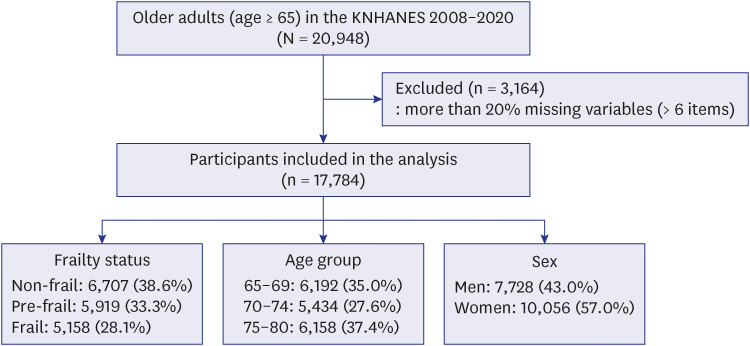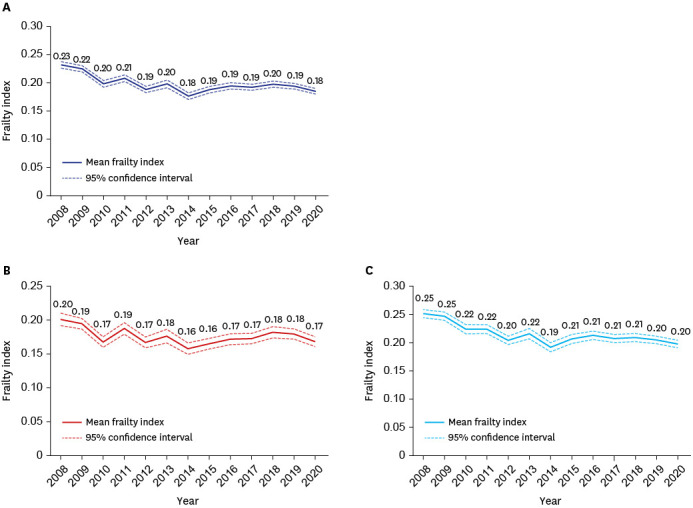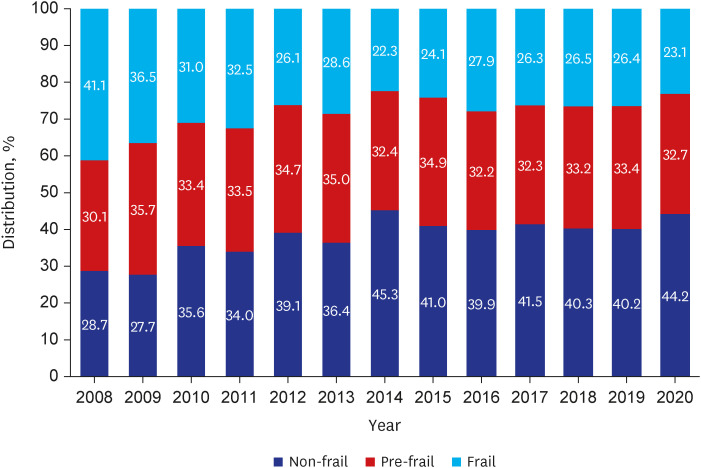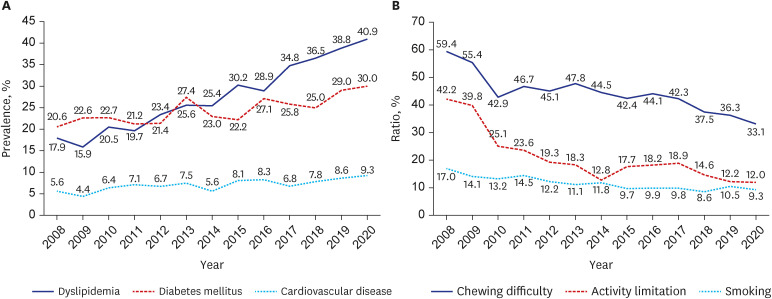J Korean Med Sci.
2023 Jul;38(29):e157. 10.3346/jkms.2023.38.e157.
Trends in Frailty Prevalence Among Older Adults in Korea: A Nationwide Study From 2008 to 2020
- Affiliations
-
- 1Department of Internal Medicine, Chonnam National University Bitgoeul Hospital, Gwangju, Korea
- 2Department of Geography, Department of Geography Education, Institute of Future Land, Korea University, Seoul, Korea
- 3Department of Epidemiology and Data Science, Amsterdam UMC, Location Vrije Universiteit Amsterdam, Amsterdam, The Netherlands
- 4Amsterdam Public Health Research Institute, Aging and Later Life Research Program, Amsterdam, The Netherlands
- 5Division of Geriatrics, Department of Internal Medicine, Asan Medical Center, University of Ulsan College of Medicine, Seoul, Korea
- KMID: 2544941
- DOI: http://doi.org/10.3346/jkms.2023.38.e157
Abstract
- Background
We aimed to evaluate the nationwide trend of the prevalence of frailty in older adults in Korea from 2008 to 2020 to inform future geriatric healthcare policies.
Methods
The study used data of individuals aged 65 years and older from the Korea National Health and Nutrition Examination Survey, a nationwide repeated cross-sectional survey. Frailty was defined using frailty index, classified as non-frail (frailty index ≤ 0.15), pre-frail (0.15 < frailty index ≤ 0.25), or frail (frailty index > 0.25).
Results
The study included 17,784 individuals, with the mean age of 72.4 and mean frailty index of 0.2. The prevalence of frailty in older adults in South Korea decreased significantly from 2008 (41.1%) to 2020 (23.1%). The decrease in the frailty index was observed in all age groups (all P < 0.05). As components of frailty index, we found that certain comorbidities, such as dyslipidemia, diabetes mellitus, and cardiovascular disease, have increased over time, while factors such as chewing difficulty, activity limitation, and smoking, have decreased.
Conclusion
The prevalence of frailty in older adults in South Korea has decreased significantly during the study period. Historical improvements in healthcare access and preventive measures may have contributed to this trend.
Keyword
Figure
Reference
-
1. Chen X, Mao G, Leng SX. Frailty syndrome: an overview. Clin Interv Aging. 2014; 9:433–441. PMID: 24672230.2. Cheng MH, Chang SF. Frailty as a risk factor for falls among community dwelling people: evidence from a meta-analysis. J Nurs Scholarsh. 2017; 49(5):529–536. PMID: 28755453.3. Chang SF, Lin HC, Cheng CL. The relationship of frailty and hospitalization among older people: evidence from a meta-analysis. J Nurs Scholarsh. 2018; 50(4):383–391. PMID: 29874399.4. Khandelwal D, Goel A, Kumar U, Gulati V, Narang R, Dey AB. Frailty is associated with longer hospital stay and increased mortality in hospitalized older patients. J Nutr Health Aging. 2012; 16(8):732–735. PMID: 23076517.5. Fried LP, Tangen CM, Walston J, Newman AB, Hirsch C, Gottdiener J, et al. Frailty in older adults: evidence for a phenotype. J Gerontol A Biol Sci Med Sci. 2001; 56(3):M146–M156. PMID: 11253156.6. Robertson DA, Savva GM, Coen RF, Kenny RA. Cognitive function in the prefrailty and frailty syndrome. J Am Geriatr Soc. 2014; 62(11):2118–2124. PMID: 25370593.7. Davies K, Maharani A, Chandola T, Todd C, Pendleton N. The longitudinal relationship between loneliness, social isolation, and frailty in older adults in England: a prospective analysis. Lancet Healthy Longev. 2021; 2(2):e70–e77. PMID: 36098160.8. Al Snih S, Graham JE, Ray LA, Samper-Ternent R, Markides KS, Ottenbacher KJ. Frailty and incidence of activities of daily living disability among older Mexican Americans. J Rehabil Med. 2009; 41(11):892–897. PMID: 19841840.9. Bandeen-Roche K, Seplaki CL, Huang J, Buta B, Kalyani RR, Varadhan R, et al. Frailty in older adults: a nationally representative profile in the United States. J Gerontol A Biol Sci Med Sci. 2015; 70(11):1427–1434. PMID: 26297656.10. Rockwood K, Mitnitski A. Frailty in relation to the accumulation of deficits. J Gerontol A Biol Sci Med Sci. 2007; 62(7):722–727. PMID: 17634318.11. Schoufour JD, Mitnitski A, Rockwood K, Evenhuis HM, Echteld MA. Development of a frailty index for older people with intellectual disabilities: results from the HA-ID study. Res Dev Disabil. 2013; 34(5):1541–1555. PMID: 23475005.12. Marcucci M, Damanti S, Germini F, Apostolo J, Bobrowicz-Campos E, Gwyther H, et al. Interventions to prevent, delay or reverse frailty in older people: a journey towards clinical guidelines. BMC Med. 2019; 17(1):193. PMID: 31660959.13. Wleklik M, Uchmanowicz I, Jankowska EA, Vitale C, Lisiak M, Drozd M, et al. Multidimensional approach to frailty. Front Psychol. 2020; 11:564. PMID: 32273868.14. Lee SW, Lee A, Yu MY, Kim SW, Kim KI, Na KY, et al. Is frailty a modifiable risk factor of future adverse outcomes in elderly patients with incident end-stage renal disease? J Korean Med Sci. 2017; 32(11):1800–1806. PMID: 28960032.15. Baek JY, Lee E, Jung HW, Jang IY. Geriatrics fact sheet in Korea 2021. Ann Geriatr Med Res. 2021; 25(2):65–71. PMID: 34187140.16. Kang E, Lee Y, Lim J, Joo B, Bae H. Long-Term Care Status Survey. Health Policy Report. Sejong: Ministry of Health & Welfare (KR);2019.17. Kojima G, Liljas AE, Iliffe S. Frailty syndrome: implications and challenges for health care policy. Risk Manag Healthc Policy. 2019; 12:23–30. PMID: 30858741.18. Hoogendijk EO, Dent E. Trajectories, transitions, and trends in frailty among older adults: a review. Ann Geriatr Med Res. 2022; 26(4):289–295. PMID: 36503183.19. Kweon S, Kim Y, Jang MJ, Kim Y, Kim K, Choi S, et al. Data resource profile: the Korea National Health and Nutrition Examination Survey (KNHANES). Int J Epidemiol. 2014; 43(1):69–77. PMID: 24585853.20. Kim Y. The Korea National Health and Nutrition Examination Survey (KNHANES): current status and challenges. Epidemiol Health. 2014; 36:e2014002. PMID: 24839580.21. Hoogendijk EO, Stolz E, Oude Voshaar RC, Deeg DJ, Huisman M, Jeuring HW. Trends in frailty and its association with mortality: results from the Longitudinal Aging Study Amsterdam, 1995-2016. Am J Epidemiol. 2021; 190(7):1316–1323. PMID: 33534876.22. Choi S, Kim YM, Shin J, Lim YH, Choi SY, Choi BY, et al. Comparison of the accuracy and errors of blood pressure measured by 2 types of non-mercury sphygmomanometers in an epidemiological survey. Medicine (Baltimore). 2018; 97(25):e10851. PMID: 29923975.23. Kang MG, Kim SW, Yoon SJ, Choi JY, Kim KI, Kim CH. Association between frailty and hypertension prevalence, treatment, and control in the elderly Korean population. Sci Rep. 2017; 7(1):7542. PMID: 28790349.24. Searle SD, Mitnitski A, Gahbauer EA, Gill TM, Rockwood K. A standard procedure for creating a frailty index. BMC Geriatr. 2008; 8(1):24. PMID: 18826625.25. Kang MG, Jung HW. Association between oral health and frailty in older Korean population: a cross-sectional study. Clin Interv Aging. 2022; 17:1863–1872. PMID: 36575660.26. Blodgett J, Theou O, Kirkland S, Andreou P, Rockwood K. Frailty in NHANES: Comparing the frailty index and phenotype. Arch Gerontol Geriatr. 2015; 60(3):464–470. PMID: 25697060.27. Won CW, Lee Y, Lee S, Kim M. Development of Korean Frailty Index for Primary Care (KFI-PC) and its criterion validity. Ann Geriatr Med Res. 2020; 24(2):125–138. PMID: 32743333.28. Kim DH, Glynn RJ, Avorn J, Lipsitz LA, Rockwood K, Pawar A, et al. Validation of a claims-based frailty index against physical performance and adverse health outcomes in the health and retirement study. J Gerontol A Biol Sci Med Sci. 2019; 74(8):1271–1276. PMID: 30165612.29. Hubbard RE, Goodwin VA, Llewellyn DJ, Warmoth K, Lang IA. Frailty, financial resources and subjective well-being in later life. Arch Gerontol Geriatr. 2014; 58(3):364–369. PMID: 24512820.30. Mousa A, Savva GM, Mitnitski A, Rockwood K, Jagger C, Brayne C, et al. Is frailty a stable predictor of mortality across time? Evidence from the Cognitive Function and Ageing Studies. Age Ageing. 2018; 47(5):721–727. PMID: 29905755.31. Wennberg AM, Ebeling M, Ek S, Meyer A, Ding M, Talbäck M, et al. Trends in frailty between 1990 to 2020 in Sweden among 75-, 85- and 95-year-old women and men: a nationwide study from Sweden. J Gerontol A Biol Sci Med Sci. 2023; 78(2):342–348. PMID: 36190806.32. Blodgett JM, Rockwood K, Theou O. Changes in the severity and lethality of age-related health deficit accumulation in the USA between 1999 and 2018: a population-based cohort study. Lancet Healthy Longev. 2021; 2(2):e96–104. PMID: 36098163.33. Makizako H, Nishita Y, Jeong S, Otsuka R, Shimada H, Iijima K, et al. Trends in the prevalence of frailty in Japan: a meta-analysis from the ILSA-J. J Frailty Aging. 2021; 10(3):211–218. PMID: 34105703.34. Suzuki T, Nishita Y, Jeong S, Shimada H, Otsuka R, Kondo K, et al. Are Japanese older adults rejuvenating? Changes in health-related measures among older community dwellers in the last decade. Rejuvenation Res. 2021; 24(1):37–48. PMID: 32498608.35. Kim KW, Kim OS. Super aging in South Korea unstoppable but mitigatable: a sub-national scale population projection for best policy planning. Spat Demogr. 2020; 8(2):155–173. PMID: 34222615.36. Kontis V, Bennett JE, Mathers CD, Li G, Foreman K, Ezzati M. Future life expectancy in 35 industrialised countries: projections with a Bayesian model ensemble. Lancet. 2017; 389(10076):1323–1335. PMID: 28236464.37. Organisation for Economic Co-operation and Development (OECD). Health at a Glance 2019: OECD Indicators. Paris: OECD Publishing;2015.38. World Health Organization (WHO) Regional Office for the Western Pacific. Republic of Korea Health System Review. Manila: WHO Regional Office for the Western Pacific;2015.39. Lee J, Hoang T, Lee S, Kim J. Association between dietary patterns and dyslipidemia in Korean women. Front Nutr. 2022; 8:756257. PMID: 35096924.40. Cho NH. Diabetes burden and prevention in Korea and the Western Pacific Region. Diabetes Res Clin Pract. 2014; 106(Suppl 2):S282–S287. PMID: 25550054.41. Kim HC, Lee H, Lee HH, Seo E, Kim E, Han J, et al. Korea hypertension fact sheet 2021: analysis of nationwide population-based data with special focus on hypertension in women. Clin Hypertens. 2022; 28(1):1. PMID: 34980274.42. Cho SM, Lee H, Lee HH, Baek J, Heo JE, Joo HJ, et al. Dyslipidemia fact sheets in Korea 2020: an analysis of nationwide population-based data. J Lipid Atheroscler. 2021; 10(2):202–209. PMID: 34095012.43. Shin JY. Trends in the prevalence and management of diabetes in Korea: 2007-2017. Epidemiol Health. 2019; 41:e2019029. PMID: 31319658.
- Full Text Links
- Actions
-
Cited
- CITED
-
- Close
- Share
- Similar articles
-
- Prevalence and Social Correlates of Frailty Among Rural Community-Dwelling Older Adults
- Trajectories, Transitions, and Trends in Frailty among Older Adults: A Review
- Delirium in Frail Older Adults
- The Evaluation of Feasibility and Predictive Validity of Comprehensive Korean Frailty Instrument: Using the 2008 and 2011 Living Profiles of Older People Survey in Korea
- Sarcopenia, Frailty, and Diabetes in Older Adults





